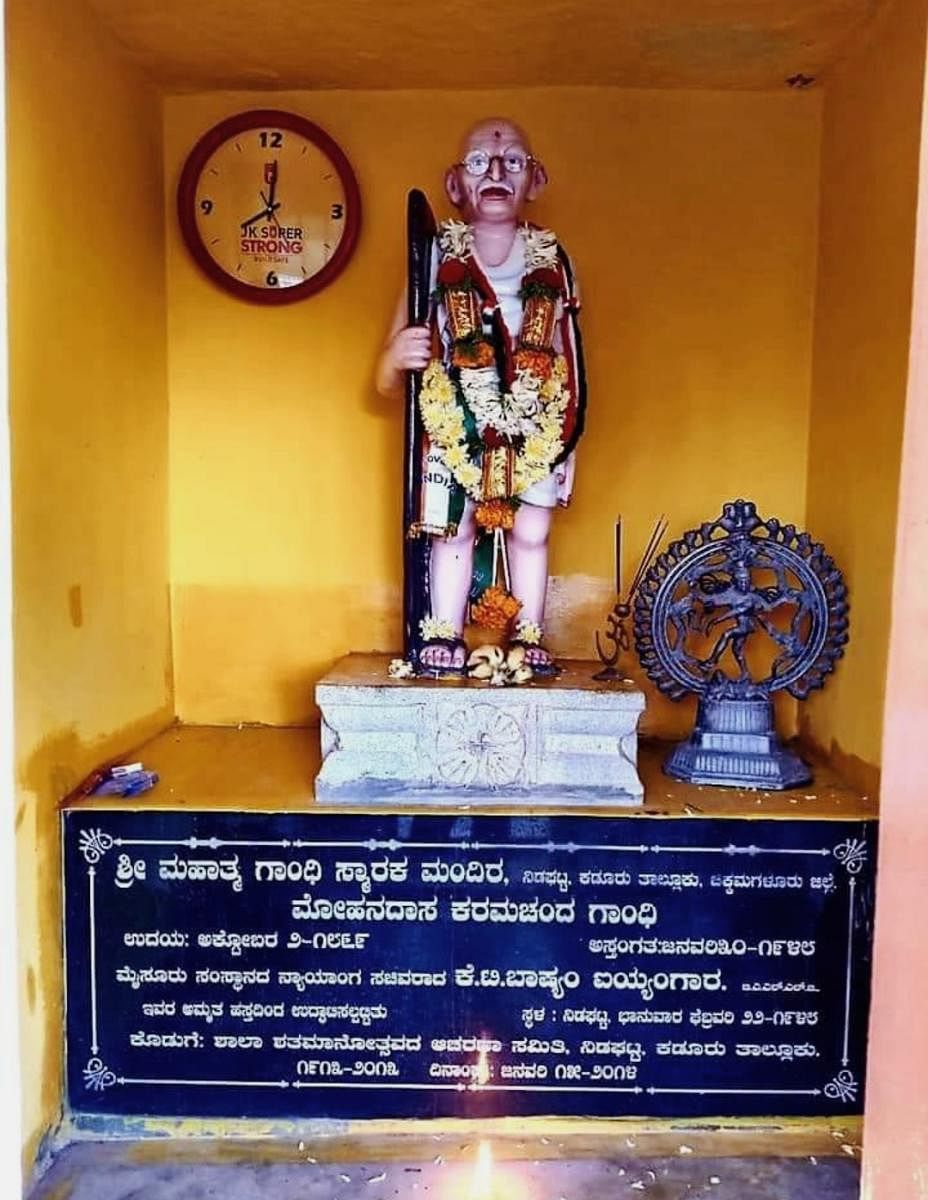

Most of us recall freedom fighters as ordinary people who rose to become leaders, fighting against colonial rule even at the cost of sacrificing their lives. But there are a few villages in Karnataka where freedom fighters have temples and are revered as Gods.
Nidghatta, a small village in Kadur taluk of Chikkamagalur district, has a small temple dedicated to Mahatma Gandhi.
During the freedom movement, a group of youngsters like N L Siddaramaiah, Ganganna, Ele Nanjappa and others from Nidghatta came under the influence of the Mahatma and participated in the Quit India movement. When they walked out of the jails after India got independence, they wanted their village to be a seat of truth and non-violence. But when Gandhi was assassinated in 1948, they were pained and went on to construct a temple to ‘immortalise’ him.
Within 48 hours of Gandhi’s death, a small temple with a two feet tall sand-stone idol of the Mahatma with a walking stick and the Bhagavad Gita was built at the place where they had celebrated the day of independence. The then Mysore Presidency Law Minister K T Bhashyam Iyengar inaugurated it.
“Our villagers worship Gandhi just like the way they worship their Anjaneyaswamy. They offer flowers, fruits, aarati and even break coconuts at the Gandhi temple. People visit this temple on auspicious occasions to seek blessings of Gandhi,” said former gram panchayat president Santosh, who ensured renovation of the temple two years back.
“Even today, Nidghatta does not have a liquor shop as per the wishes of Gandhiji. The people here also believe in self-reliance and 90% of them have continued with agriculture as their main profession. However, the younger generation fails to understand the importance of independence and Gandhian principles,” said Balu Matcheri, a localite.
Apart from this, there are temples dedicated to Mahatma Gandhi at Balshettihal village in Surpur taluk of Yadgir district constructed in 1949, Hartikote in Chitradurga district and at Ankola in Uttara Kannada district also.
At Jakkali village in Ron taluk of Gadag district, which is known as Gandhi Gram, people worship Gandhi in the small ‘Gudi’ (as it is called) constructed in the government school premises.
“When Gandhi visited Jakkali on March 3, 1934, he spoke about the freedom movement, eradicating untouchability, village sanitation, ban on liquor, khadi and self-reliance of villages. Inspired by him, hundreds of people who had thronged the venue became staunch followers of Gandhian principles and engaged in the freedom movement,” said Ravindranath Doddameti, grandson of Andanappa Doddameti, a freedom fighter who had invited Gandhi to Jakkali and played a major role in the unification of Karnataka.
In the memory of Gandhi’s visit to their village, the people of Jakkali installed an idol of Gandhi in a sitting position in 1970 and began worshipping it. The idol was sculpted by Gandhian Somappa Kammar.
“The teachers of the school regularly clean the idol and students pay obeisance before their morning prayer. Teachers tell stories of freedom fighters to students to inspire them. People also bow down before the idol while taking up sowing. Many have even named their children as Gandhi,” added Doddameti, while lamenting that the current-generation youth was slowly drifting away from Gandhian principles.
Sangolli Rayanna’s temple
For the people of Nandgad in Khanapur taluk of Belagavi district, warrior Sangolli Rayanna is their ‘God’.
Rayanna, the trusted army chief of Kittur Rani Channamma, was born on August 15, 1796 and was hanged to death from a Banyan tree near Nandgad by the British on January 26, 1831. As per his last wish, he was hanged outside Nandgad and his memorial was constructed inside Nandgad.
Today, the place of his memorial (Punya Bhoomi) has turned into a temple memorial and a pilgrim centre of sorts.
“Every day, a pujari (priest) offers abhisheka to Rayanna and on occasions like his birth and death anniversaries, mass feeding programmes are held. We also honour achievers. However, on August 15 this year, we have not arranged such programmes as precautionary measures,” said Shankar Sunoli who leads the Shree Krantiveer Sangolli Rayanna Abhivrudhi Samithi of Nandgad.
He adds that for the last one-and-a-half years, the villagers have been planting one sapling each day in the vicinity of the Punya Bhoomi in memory of Rayanna.
Another interesting thing is that the people of Nandgad respect Rayanna so much that they swear in the name of Rayanna instead of God. Before taking any important
decision of their life or during auspicious occasions, they visit this ‘temple’. They tie miniature cradles at the banyan tree at the Punya Bhoomi and wish for brave children like Rayanna.